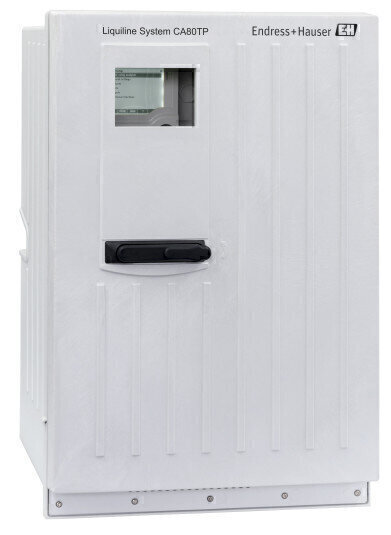Water/Wastewater
Liquiline Analyser Measures Total Phosphorus on-line, Dramatically Reducing Time to Obtain Results compared to Lab Methods.
Sep 13 2017
Endress+Hauser introduces the Liquiline CA80TP phosphorus analyser for monitoring industrial wastewater, and inlet and outlet streams of municipal wastewater treatment plants. The CA80TP uses a thermal digestion technique along with colorimetric analysis, requiring only a small quantity of reagents. With online measurement there is no waiting for time-consuming lab analysis.
In most industrial and water and wastewater plants, phosphorus measurements require that a technician pull a sample manually and take it to a lab for analysis. With the CA80TP, the phosphorus measurement is performed on line, as accurate as a lab analyzer, and much less time consuming.
The CA80TP measures phosphorus in ranges of 0.05 to 10 mg/l or 0.5 to 50 mg/l. It has two 4-20mA outputs with the option for additional outputs including Modbus RS485, Modbus TCP and EtherNet/IP. The 4-20mA outputs transmit the phosphorus measurement value. The other outputs can be used to transmit the process variable, plus status and diagnostic information.
Phosphorus occurs as phosphate in natural water systems and in wastewater. Phosphates enter the water from fertilisers, biological and industrial waste and wastewater—and from substances added in water treatment for corrosion protection. Phosphate is a nutrient, so over-enrichment of phosphate (eutrophication) leads to excessive growth of aquatic plants. When these plants die in the fall, the decay of the additional biomass increases the rate of oxygen consumption. In extreme cases, this may lead to fish kills and decrease the quality of the water system.
To determine total phosphorus, a sample must be digested. Samples are drawn from the process using a suction strainer or can be taken from a bypass piping system using an Endress+Hauser Y Strainer.
A precise sample volume is digested at high temperature with a digestion reagent. An optical dosing unit, used to dose sample and reagents, uses a redundant light barrier for a high level of reliability, guaranteeing precise and reproducible results from extremely small volumes of reagent. The temperature in the reaction vessel is kept constant to ensure complete digestion takes place within a short period of time. The CA80TP has a software-controlled safety cover to prevent access to the digestion reactor when it is under operation.
Following digestion, the sample is mixed with colorimetric analysis reagents, causing a characteristic change in the sample color. A photometer measures the level of absorption by the sample at defined wavelengths.
The analyser can be equipped with an energy-efficient cooling system to maintain reagent quality and increase lifespan. Automatic cleaning and calibration functions ensure the analyser works reliably and without manual intervention over an extended period of time.
If disturbances should occur, advanced diagnostics with remote access help plant personnel analyse and remedy any issues quickly. Required maintenance measures can be carried out easily, increasing process uptime while reducing maintenance costs.
Digital Edition
IET 34.2 March 2024
April 2024
Gas Detection - Biogas batch fermentation system for laboratory use with automatic gas analysis in real time Water/Wastewater - Upcycling sensors for sustainable nature management - Prist...
View all digital editions
Events
Apr 30 2024 Melbourne, Australia
Apr 30 2024 Birmingham, UK
May 03 2024 Seoul, South Korea
May 05 2024 Seville, Spain
May 06 2024 Minneapolis, MN, USA


















